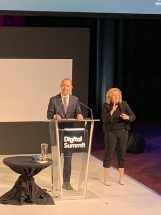A pilot baby registration program being coordinated by the Digital Transformation Agency (DTA) will remove some of the ‘pain points’ for new parents in terms of dealing with government, a conference has heard.
Under the government’s digital transformation strategy, the DTA has committed to streamlining a range of complicated and cross-jurisdictional life-event services – like births, starting school, marriage, retirement and death – into a single process.

It is currently coordinating a birth-of-a-child pilot program involving the Department of Human Services and the ACT, NSW and Queensland governments, DTA CEO Randall Brugeaud told the Digital Summit 2019 in Canberra on Thursday.
Mr Brugeaud said the pilot will deliver an integrated service experience for parents of newborns, and is designed to streamline the process of registering the birth of a child and enrolling it in Medicare and Centrelink services.
According to the strategy, by 2025 expectant parents will be able to use the myGov digital platform to access information about childcare, immunisation and maternity leave. When the baby is born, and with consent from the parents, proof-of-birth data from the hospital will automatically trigger a digital identity, Medicare and Centrelink record, and My Health Record for the newborn.
Taking a life-events approach
Taking a “life-events” approach to service delivery can give a better understanding of when people need to interact with the government at different points in their lives, Mr Brugeaud said.
“Life events typically require many interactions, often spanning multiples levels of government, as well as third party and industry providers,” he said.
Some of these interactions are “delightful” but many of them are not, he said.
“While individual life events present a narrow view of pain points, a collection of life events provides a much broader view,” he said.
“Pain points” exist across life events in terms of government interaction, Mr Brugeaud said.
These can include difficulty finding the right information at the right time, being required to provide information multiples times, being unclear about the pathway to reach an outcome and not meeting service delivery expectations.
“Given these things aren’t isolated to one level of government or one organisation, it makes sense for us to solve these problems collaboratively,” Mr Brugeaud said.
“A simpler service for parents is also expected to increase the number of birth registrations, which underpins some of our most important national data and social policy assets,” he added.
Keeping up with private sector service delivery
Mr Brugeaud said the challenge for the public sector is to deliver “fast, efficient and tailored services” to users across different jurisdictions.
“Australians expect government services to be simple, seamless and secure because that’s their experience in banking, travelling and shopping,” he said.
“Public sector services need to be just as good or better than those provided by the private sector.”
This begins with ensuring that government services are “simple, well designed and user-centered”, he said.
“Understanding and responding to user needs is at the core of the government’s vision for service delivery,” he said.





Jesus Christ. This is the Australia Card by another name and route. Our governments can’t stop hacks, cops illegally checking on their ex partners secret addresses, etc, etc. We can’t control Centrelink from sending its scandalous robodebt letters that put the onus of proof on the individual to prove they don’t have a debt.
I don’t know about those blokes Matthew, Mark, Luke and John, but George Orwell was clearly a prophet. He was just out by 100 years but in prophesy that’s no shame.
Awesome ideas guy, this way bubba can be quickly identified before sitting down with it’s distressed parents in the hospital waiting room for the next 6 hours, unattended and uncared for!?! As ususal, GOVT focusing on the wrong problem. How about you address horrendous waiting lines in Public Hospitals emergency and triage departments (been unacceptable for last 30 years), or the massive rise in health insurance?
I have worked in the information management industry for 46 years and while I have been aggregating information for the benefit of the general public in state and local government jurisdictions since starting in the profession I do have reservations in aggregating personal information on this scale. While the concept is great and will, I hope, improve service delivery I am extremely concerned in relation to the privacy and security implications and the temptation constantly being present in Government to utilise datasets for any other than the purpose they were set up for and only that purpose. eg creeping changes in the regulatory/legislative environment that allow an alternate use. eg national security legislation. I this regard I would like to see inserted in the relevant legislation or indeed one piece of new legislation a statement preventing such use and strengthen it with criminal penalties and or strong fines for non compliance